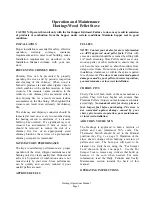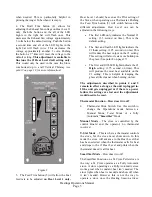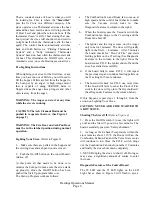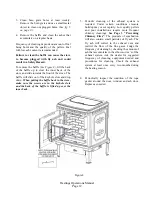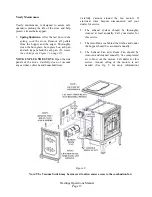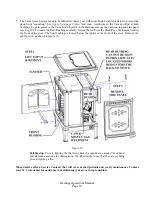
Hastings
Operations Manual
Page 4
A different type of heater.
The pellet stove is
neither a cord wood stove nor a furnace. Its
operation and maintenance differ from the tra-
ditional wood stove. FOLLOW THESE
OPERATING INSTRUCTIONS EXACTLY AS
STATED TO ENSURE SAFE AND RELIABLE
OPERATION.
1. Carefully read this “Operation and Mainte-
nance” manual in its entirety BEFORE lighting
your stove for the first time.
2. Obtain final inspection and approval of
installation from local building officials.
3. Carefully clean all marks off the gold plated
parts before the first fire is lighted. Use a soft
cloth and a “Windex” type cleaner.
Caution:
Never use an abrasive cleaner on any plated or
painted parts of the stove.
4. Have your dealer demonstrate all the opera-
tional and maintenance steps necessary for proper
use of the stove. Sign and return the warranty
card, to the address listed on the back page.
5. Some odors may be given off during the first
few hours of burning during initial break-in.
These odors are normal and not harmful.
However, ventilating the room until the odors
disappear is recommended.
6. The stove will become HOT while in
operation. Keep children, clothing and furniture
away from all stove surfaces.
WARNING: Direct
contact with the stove while operating may
cause skin burns.
7. To avoid the possibility of smoke and/or sparks
entering the room always keep firebox and de-
ashing doors closed whenever the stove is
operating.
8. A certain amount of carbon monoxide may be
produced within the stove as a by-product of
combustion. All exhaust vent connections must
be sealed with RTV silicone to assure a gas tight
seal. Any leaks into a confined area caused by
faulty installation or improper operation of the
stove could produce dizziness, nausea and in
extreme cases, death.
9. An outside source of combustion air is required
on all mobile home installations. If room air is
used to supply combustion air, room air
starvation, operation of exhaust fans and icing of
air vents can adversely affect proper stove operation.
If these conditions exist, outside air should be used.
10. Smoke detectors, installed in the same general
area as the stove, may be activated if the stove door
is left open and smoke is allowed to enter the area.
CONTROL BOARD FEATURES
READ “FREQUENTLY ASKED QUESTIONS”
ON PAGES 15-19 BEFORE OPERATING THE
STOVE.
The Control Board controls all functions of the
Stove by monitoring sensors that are in the system.
These sensors serve 2 purposes.
a.
General Operation of the Stove.
b.
Safety Features, to shut the unit down in the
event the sensors detect a problem in the
unit.
The Control Board also has Diagnostic Capabilities
to help in diagnosing 3 areas in the Stove. These
areas are:
1.
High Temperature Limit.
2.
Proof of Fire Sensor
3.
Vacuum in the Firebox
A closer look at the Control Board on page 5, in
figure 2 will explain how the board works. There are
five buttons labeled 1 through 5, a slide switch
labeled 6 and a LED Light bar with 5 Heat Settings.
The LED Light bar is also used during the
Diagnostic process, see page 6 and 7 for more
details.
The buttons on the board function as follows:
(Refer
to Figure 2. The touch pad buttons and Slide Switch
are labeled with the white numbers 1 through 6)
1. The Heat Level button (1) will advance the
setting between level 1 and 5. Once you reach level
5, it will drop back to level 1. Each level has a LED
light to indicate where the board is set.
2. The On/Off button (2) turns the Stove On and
Off. It will also reset the board after the board has
sensed a problem and is flashing a Diagnostic code.
3.
The auger button (3) will allow the customer to
manually auger pellets into the burn pot on start up




